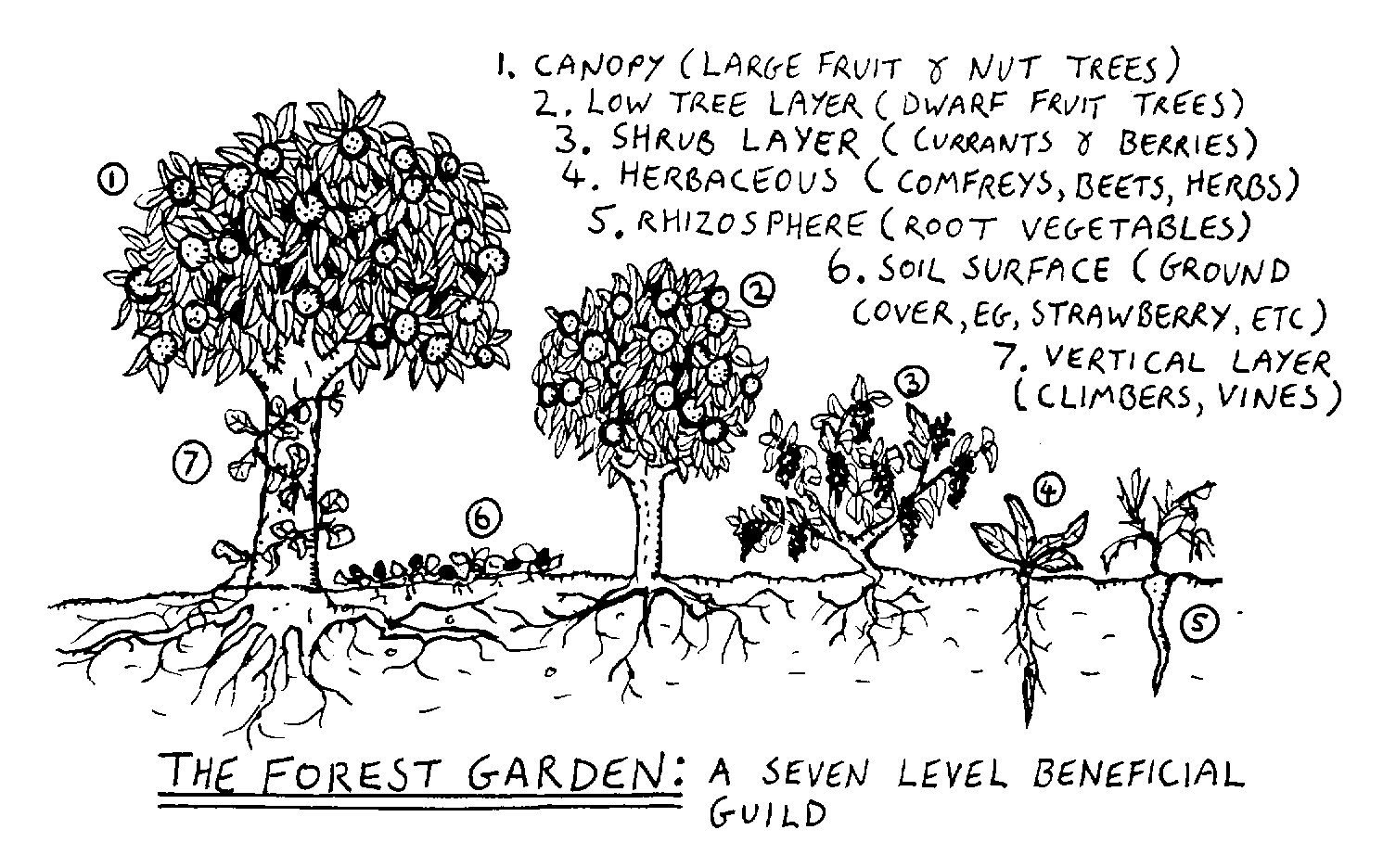Land Design
Humid Tropics
Zone 1: Orderly Gardens
- You’ll need lots of shade to mitigate the intense mid-day sun (palm and papaya trees can be used for shade, among others).
- Always cover the soil to prevent erosion of topsoil (ground covers, mulch).
- Raised beds prevent overwatering from heavy rains.
- This part of the garden should be heavy with root crops like cassava, taro, sweet potato, etc.
- Mulched pit gardens are highly economical for space, for example, banana or coconut circles planted with root crops.
- Allow for the free range of chickens through these systems to remove pests and break down mulch.
- Keep everything in this zone low-profile. You don’t want any buildings or anything tall near the house, as they block cooling winds.
Zone 2: Food Forests
- Fast-growing legume trees.
- Lots of fruit: breadfruit, mangos, jackfruit, avocado, and more.
- Plant as much understory (layer of vegetation beneath the main canopy of a forest) as you can inside your forest, for example, coffee and cacao would be good for this purpose.
- Plant non-parasitic vines that will climb trees for multi-story growing.
- Make sure to always crop mulch and legume mulch just before the rains start.
- Small crop gardens scattered throughout.
- Shallow topsoil.
- Cut and carry forage from the food forest to large animals to prevent soil compaction.
- Position animal housing on contour or swales to allow the distribution of manures into the food forest by rainfall.
Zone 4
- Use alley cropping (planting rows of trees wide apart with a companion crop grown in the alleyways between) for your main crops. This is best used between pollarded (a pruning system involving the removal of the upper branches of a tree) leguminous trees, increasing fertility.
- Suitable for aquatic systems.
- Fish, water plants, rice, pit gardens.
- Grow productive trees on the water’s edge, especially fish-feed producing plants.
- Animal housing over ponds will increase fertility in the water and save space.
- In subtropics, intensive rotational grazing of small paddocks used (we’ll cover this in-depth later in our lesson on sustainable grazing practices).
Temperate Climate (Cool To Cold And Humid)
Zone 1: Orderly Gardens
- Here there will be annual fluctuations in day length.
- Extend seasons using greenhouses.
- Hedges used as fencing.
- Compost only during warm months.
- Use hügelkultur beds (soil-covered piles of waste logs and timber turned into raised beds).
- Your footpaths are mulched.
- Place espaliered trees (pruned with branches tied to a frame) on walls to extend seasons using retained thermal mass heat.
Zone 2: Food Forests
- Legume trees (honey and black locust trees used in the United States).
- Main crops planted on contour (same elevation), using hedges for windbreaks.
- Apples, cherries, pears, nut trees.
- Berry bushes in the understory.
- Coppicing for firewood (a method of cutting trees almost to the root to stimulate growth).
- Cut forage for silage to compact and ferment it in sealed containers in anaerobic conditions to preserve it and increase nutrients.
Zone 3
- Trees on swales.
- Forage between swales.
- Larger pastures and crop fields.
- Animals kept off swales to avoid compaction.
- Intensive rotational grazing (return every one to two months to re-graze).
Drylands
Zone 1: Orderly Gardens
- Water is the limiting factor here, use compost in soil to help retain moisture.
- Summer heat is dangerous for your plants, you’ll need to accommodate your garden with 50% shade overhead using either shade cloth or palm trees.
- Trellis on walls to cool any buildings.
Zone 2: Food Forests
- Shade is essential here, too, so place drought-tolerant trees (carob, date palms, etc.) throughout.
- Fast-growing legumes as firewood.
- Olive and fruit trees (mulberry, guava, pomegranate).
- Small crop gardens (5,000–1,000 square yards; 1/8 – 1/4 acre).
Zone 3
- Large swales with trees planted on the downhill side and bushes planted on the mound.
- Legumes pollarded for fuel and small lumber.
- Crop fields planted just before rains.
- Windbreaks of trees and bushes needed for the main crop fields.
- Dryland animals are more commonly browsers not grazers, plant leguminous forage trees for them.
Subtropics
The tropics start at 23 degrees north or south of the equator and run to the equator.
The subtropics start at 40 degrees north or south of the equator and run to the tropics at 23 degrees north of south of the equator.
In dealing with the three main climate profiles (desert, cold temperate, and tropics), we leave out some minor climate profiles that we discussed yesterday. The sub-tropics, for example, combine elements of temperate and humid tropical climates, so we need to cherry-pick some guidelines from each.
How far into the subtropics you are will dictate how much you look to tropical or temperate climates for guidelines. Generally, conditions during summer months in the subtropics should follow tropical guidelines. When in doubt about what action to take in winter, take your instruction from temperate climate guidelines.

